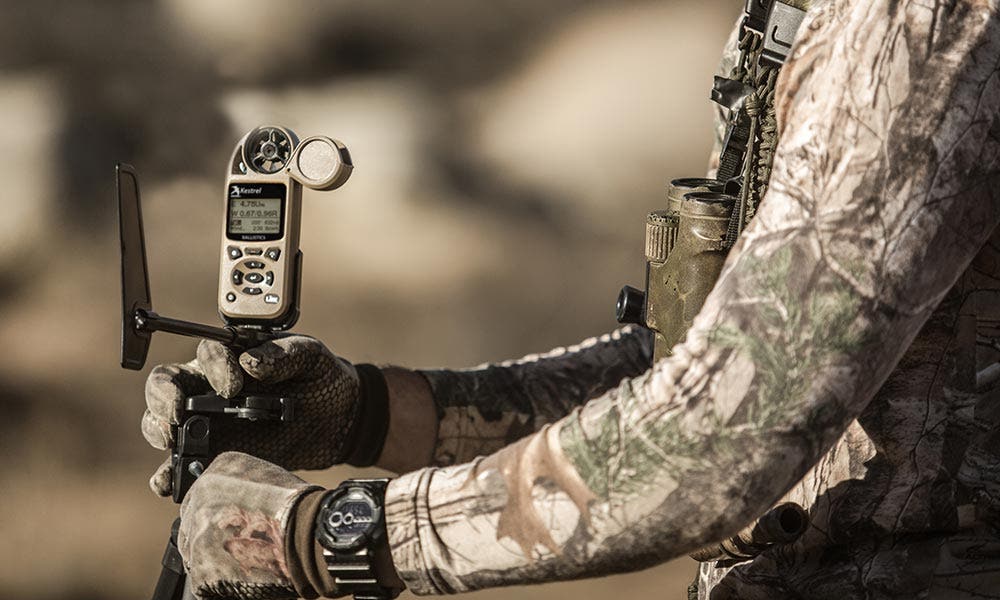Using Kestrel Devices to Make Sighting In Easier

Sighting in a Firearm for Hunting with Kestrel Devices
Whenever you get a new rifle or new-to-you rifle, it’s important to take time to sight it in correctly. While sighting in a rifle isn’t necessarily a hard thing to do, it can take time. And if you’re hoping to sight it in for long-range hunting , it will be much easier if you have a few shooting accessories to help you out. That’s where Kestrel devices come into play. We have plenty of shooting tools to help turn your new rifle into a tack driver downrange.
How to Sight in a Rifle
If you’ve just installed a new scope on a rifle or are just getting a completely new rifle with the scope already mounted, it helps to start the process by shooting at short distances. That way, you should be able to at least hit the paper target and then determine how to adjust the scope from there. A good rule of thumb is to start at about 25 yards. Now we know that ammunition isn’t exactly cheap or common these days. But ideally, you would take a couple of shots to see where you’re grouping them (rather than just a single shot). At 25 yards, you should be hitting higher than the bullseye/aiming point anyway.

From there, you can adjust the windage and elevation turrets on your rifle scope accordingly. The windage turret will adjust the side-to-side (i.e., horizontal) placement of your bullet impact point, while the elevation turret will adjust the up-and-down (i.e., vertical) placement. If your shots are off to the right or left of the bullseye, you should definitely adjust that first so you’re at least hitting dead center from a side-to-side perspective. Then you can move out to shooting at 75 yards to see where you hit. It should be lower on the target than where you hit at 25 yards. You can continue this basic process out to as far as you ideally want to shoot. Once you get to that distance, you should continue to adjust the windage and elevation so you can zero your rifle in on the bullseye at that distance. From then on, you can adjust your aiming point based on that zero distance. For example, if you’re shooting at a deer at 150 yards but your rifle is zeroed at 100 yards, you’d want to aim higher by a certain margin.
The distance you zero your rifle at will depend on where and what you hunt. Most whitetail hunts would do just fine with a rifle zeroed at 75-100 yards, while elk hunts out west may require you to sight it in at 150 yards or more. This becomes trickier as you move out to long-range distances, and that’s when Kestrel devices can be very helpful for this process. As you increase the distance, atmospheric conditions (e.g., wind) can impact your bullet trajectory.
Helpful Kestrel Devices for Sighting in a Firearm
While you can generally sight a rifle in fairly easily if you’re only shooting at 100 yards, there are a few different shooting accessories that will really make this process easier if you’d like to sight your rifle in to shoot at extreme ranges.

Rangefinding Binoculars – as you shoot at targets at different distances, you will need to know exactly how far out you are from your target so you can adjust your scope turrets accurately. Kestrel binoculars and rangefinders are top-notch and can sync up with ballistics meters as well. Some models range out to 3,000+ yards, so you will never have to worry about them not going far enough. Because of this extended range, you can also generally tell where you hit your target without having to run downrange and confirm. The rangefinding binoculars also combine the features of both, so you don’t have to carry multiple tools in the field.
Ballistics Meters – Kestrel ballistics meters should be considered necessary for any truly long-range shooting or hunting situations (e.g., shots out past 400 yards). These handheld Kestrel devices combine an integrated ballistics calculator with an analysis of atmospheric conditions to help you adjust holdovers for your elevation and windage accordingly. This helps you put a shot exactly where you need to the first time.
Weather Station – if you’re serious about sighting in multiple rifles at a dedicated shooting range you have access to, it can often pay to invest in a weather station. You can easily place these stations at your shooting range to record atmospheric conditions and help integrate that information with a ballistics meter so you can deliver accurate downrange shots.
With these simple steps and useful Kestrel devices, we hope you’ll enjoy sighting in a new firearm. When done right, it’s actually a fun process.








